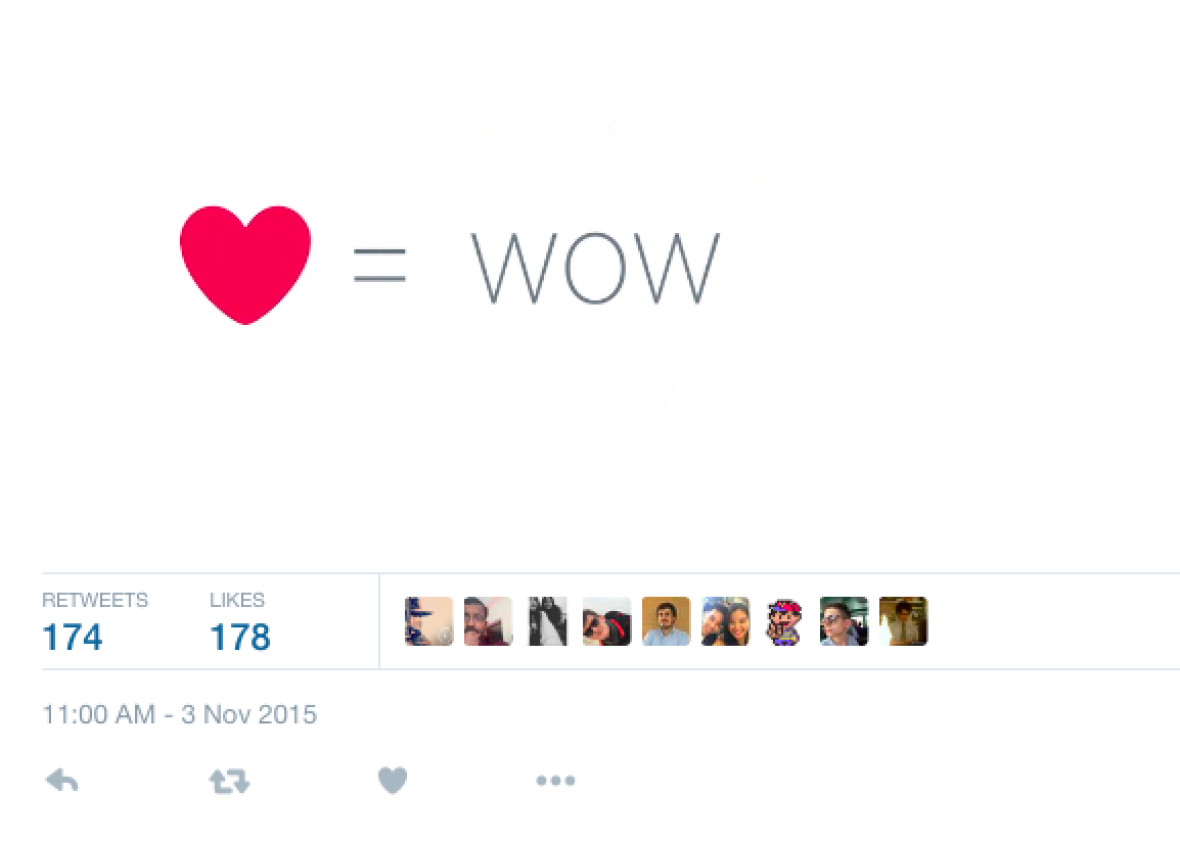You can finally stop pretending every tweet is your favorite.
Twitter is doing away with its “favorite” button and star icon, the company announced Tuesday morning. It’s replacing the stars with hearts, and they’ll now be called “likes.”
The change takes effect today on Twitter.com, the mobile Twitter app, TweetDeck, and Vine’s Android app. Vine for iOS and the Twitter desktop app for Mac will soon follow. Here’s the statement from Twitter:
We are changing our star icon for favorites to a heart and we’ll be calling them likes. We want to make Twitter easier and more rewarding to use, and we know that at times the star could be confusing, especially to newcomers. You might like a lot of things, but not everything can be your favorite.
The heart, in contrast, is a universal symbol that resonates across languages, cultures, and time zones. The heart is more expressive, enabling you to convey a range of emotions and easily connect with people. And in our tests, we found that people loved it.
Expect lots of griping from hardcore Twitter users, who tend to view every little tweak to the service’s interface as the beginning of the end, if not the end, period. (Remember how those blue lines were going to ruin Twitter forever?) Others will cry that Twitter is ripping off Facebook—forgetting that Facebook itself was accused of ripping off FriendFeed when it introduced the like button in 2009.
Don’t listen to them. This is a smart move, and it’s exactly the sort of tweak Twitter needs to make if it wants to appeal to a broader audience and start growing again. It also shouldn’t come as much of a surprise to those who have been paying attention.
Whereas Facebook’s “like” button was instantly iconic, Twitter’s “favorite” button has always been a little problematic.
For starters, “favorite” is a noun, not a verb. It’s also sort of a mouthful, leading some to shorten it to “fave” or “fav,” with all the spelling and pronunciation confusion those entail. A more serious limitation, for the purposes of a social network, is that “favorite” is a superlative. You can like any number of things, but only one can be your favorite.
That was the point that activist Twitter investor Chris Sacca made when he argued in June that Twitter should trade in its stars for hearts. “Favorite,” he wrote, “is too strong a word.” He went on:
In the early days of Twitter many of us interpreted the word literally and only keep a few Tweets in our favorites that were truly, well, our favorites. Today, many of my friends and I use the star as a “Like” button equivalent or even a simple acknowledgement that we saw a Tweet. Whereas other people use favorites as bookmarks. However, the majority of users are baffled by favorites and they don’t end up using the star much, if at all.
In contrast, Sacca wrote, “If Twitter integrated a simple heart gesture into each Tweet, engagement across the entire service would explode. More of us would be getting loving feedback on our posts and that would directly encourage more posting and more frequent visits to Twitter.”
The ambiguity of the “favorite” button was not without its charm. It spawned a cottage industry of blog posts that attempted to explain what it was, how to use it, and what it might mean when someone uses it on you. Time’s Jessica Roy identified the “flirt fav,” the “hate fav,” and the “I agree with your ideology” fav, among others. Writing in the Wire, Rebecca Greenfield added to the list the “fist-bump favorite” and the “too hot to tweet” favorite. I covered a scientific paper in which researchers surveyed more than 600 Twitter users to come up with a definitive list of 25 types of favorites.
That’s all well and good for those who have time to concern themselves with such nuances. Confusing features are fine if your goal is to appeal to a relatively exclusive group of power users who enjoy being in the know. They can even be a virtue: Just ask Snapchat.
But it’s telling that Facebook never had to explain to people what a “like” was. If Twitter is to make inroads with users who don’t want to spend hours figuring out the intricacies of its service, it needs to become simpler and more intuitive, even if it means aggravating some loyalists. Jack Dorsey, Twitter’s new CEO, gets that. I wrote when he was interim CEO that his vision of Twitter’s future looked a little more like Facebook. Because he co-founded Twitter, he has the leeway to change core features that were viewed as inviolable by his predecessors. This is one of those changes. And for all the whining that is likely to greet the move today, I think it will be viewed in retrospect as not only the right decision but an obvious one.
